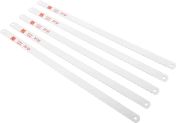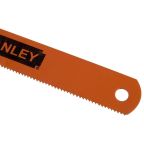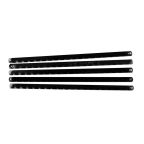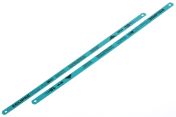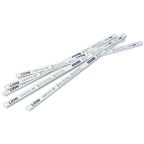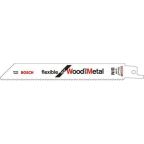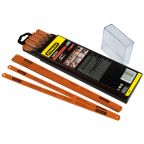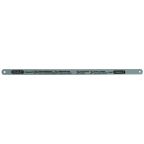Hand Saw Blades
Hand saw blades are metal blades with cutting edges fixed to the handles of manual hand saws. These blades can have teeth or sharp wire edges, each designed for specific applications and materials. The cutting style and performance of hand saw blades are influenced primarily by the blade’s Teeth Per Inch (TPI) and overall size. In tandem, both these factors will affect what the blade can effectively cut and how fast or fine the cut will be.
The material composition of the blade also influence its feasability for different tasks; for example, high-speed steel (HSS) blades can be used for cutting metals, while tungsten carbide grit blades are more effective on abrasive materials. Understanding your project requirements helps select the most appropriate blade type.
For detailed hacksaw usage, refer to our dedicated guide.
Proper maintenance of hand saw blades is essential. Keeping blades clean, straight, and dry ensures optimal cutting performance, prolongs tool life, and improves user safety. Replace blades showing wear, damage, or dullness promptly to maintain cutting efficiency.
What Types of Blades Does RS Sell?
RS offers a comprehensive range of hand saw blades across various saw types:
- Hacksaw Blades: Designed primarily for metal cutting with different tooth configurations and hardness levels.
- Knife Saw Blades: Suitable for precise wood and plastic cutting.
- Pad Saw Blades: Ideal for general-purpose wood and plastic cutting.
- Rodsaw Blades: Abrasive grit-coated blades for cutting ceramics, glass, and composite materials.
These blades come in a variety of sizes, tooth counts (TPI), and finishes. Whether you are looking for a replacement blade for your regular tool or you need a blade that meets specific requirements for your application, RS can help you.
Choosing the Right Hand Saw Blade for Your Project
Selecting the correct hand saw blade is crucial for achieving optimal results and efficiency in your cutting tasks. Consider these factors when choosing a blade:
- Material Compatibility: Match the blade to the material you're cutting, whether it's wood, plastic, or metal. Specialised hacksaw blades are designed specifically for metals, while others are suited for wood or plastics, ensuring effective cutting without damage.
- Type of Cut: Determine if you need a crosscut for cutting across the grain, a rip cut for cutting along the grain, or a finer blade for intricate detail work. Tooth geometry and set of the hand saw are key to achieving these different cut types.
- Blade Length: Blade length impacts both cutting capacity, and manoeuvrability. Longer blades handle larger workpieces efficiently, while a smaller blade offers better control and access in confined spaces, ideal for precision work.
- Tooth Count (TPI): The number of teeth per inch (TPI) on a blade directly affects cut speed and finish. Fewer teeth result in faster, rougher cuts, whereas a higher tooth count provides a slower but much finer, smoother finish on the material.
- Handle Comfort: An ergonomically designed handle on your hand saw is vital for control, comfort, and reducing fatigue during prolonged use. A comfortable grip minimises strain and improves cutting accuracy.
- Desired Finish: Your required finish dictates blade choice. For rough construction cuts, a coarser tooth pattern is acceptable. However, for cabinetry or precise work, a fine-toothed blade ensures a clean, smooth edge, minimising the need for post-cutting finishing.
How to Identify Different Hacksaw Blades
Understanding the distinct types of hacksaw blades is essential for selecting the correct blade for your cutting task. Each hacksaw blade type offers unique characteristics suited to different materials and cutting requirements.
Flexible Hacksaw Blades
Flexible hacksaw blades feature hardened teeth but a more flexible body, typically made from high-speed steel (HSS) for the teeth and a spring alloy steel for the body. You can identify them by their ability to bend significantly without breaking. They are ideal for general-purpose cutting, especially for metals like conduit or pipes, offering greater safety and break resistance in workshops across Malaysia.
All Hard Hacksaw Blades
An all hard hacksaw blade is hardened throughout its entire length, typically constructed from high-speed steel (HSS). These hacksaw blades are very rigid, offering superior precision for straight cuts but will snap if bent too far. They are best suited for experienced users performing fine, accurate cuts on harder metals in fabrication shops and industrial settings.
Rodsaw Blades
Rodsaw blades stand out with their abrasive cutting edge, featuring no traditional teeth. They are typically coated with tungsten carbide grit or diamond grit, resembling a textured rod rather than a flat blade. These versatile blades are excellent for cutting materials like ceramics, tiles, glass, fibreglass, and even hardened metals or composites, finding specialised industrial applications in Malaysia.
Power Hacksaw Blades
Power hacksaw blades are significantly larger and thicker than handsaw blades, designed exclusively for use in powered reciprocating cutting machines. Made from high-speed steel or bi-metal, they are identifiable by their substantial size and mounting holes for machine attachment. These hacksaw blades are engineered for high-volume cutting of large metal sections in industrial production lines and heavy fabrication in Malaysia.
Common Materials Cut by Hand Saw Blades
Selecting the correct hand saw blade is paramount, as different materials require specific tooth configurations and blade types for effective and clean cuts.
- Wood: For general woodworking, handsaws designed for crosscutting (across the grain) or ripping (along the grain) are ideal. Panel saws offer versatility, while a small coping saw is best for intricate curves in thinner wood.
- Metal: Hacksaw blades are the primary choice for metals, including steel, copper, and aluminium. For heavy-duty industrial tasks, power hacksaws utilise robust blades designed for efficient cutting of larger metal sections.
- Plastic: When cutting plastics, a fine-toothed hacksaw blade is often recommended to achieve clean edges and prevent chipping. Coping saws or even utility knives can also be suitable for lighter plastics.
- Ceramic: Specialised blades are required for hard materials like ceramic tiles. Rodsaw blades, featuring abrasive tungsten carbide or diamond grit, effectively cut through ceramics and other abrasive materials.
- Plasterboard: For cutting plasterboard or drywall, jab saws (also known as drywall saws) are specifically designed for efficient plunge cuts and rough shaping. Their aggressive teeth and pointed tip make quick work of these materials.
Advantages of Using Specialised Hand Saw Blades
Using specialised hand saw blades offers significant advantages over general-purpose types, leading to superior results and enhanced productivity in various cutting applications.
- Cleaner Cuts: Specialised blades feature precise tooth geometries and often finer TPI counts, resulting in smoother, more accurate cuts that minimises splintering in wood or burrs on metal and reducing the need for post-cutting finishing work.
- Greater Efficiency: The right blade matched to the material and cut type ensures maximum cutting efficiency. For instance, specific hacksaw blades for metals allow for faster material removal with less effort, optimising your workflow compared to unsuitable handsaw types.
- Longer Blade Life: Employing the correct blade for the task minimises unnecessary wear and stress on the blade itself.
- Suitability for Specific Tasks: Specialised blades are uniquely designed for particular applications where general-purpose handsaws would struggle. Examples include dovetail blades for intricate joinery in woodworking, or rodsaw blades specifically engineered for cutting ceramics, glass, or other abrasive materials.
Safety Tips When Using Hand Saw Blades
Following crucial safety tips is paramount when working with hand saw blades to prevent injuries and ensure effective, controlled cutting. Always prioritise adherence to manufacturer guidelines and employ safe cutting techniques.
- Wear Protective Gear: Always wear appropriate personal protective equipment (PPE), including safety glasses to shield against flying debris and sturdy gloves to protect hands from cuts and abrasions when handling any blade.
- Secure the Material: Firmly secure your workpiece in a vice, clamps, or with a stable brace before cutting. This prevents the material from shifting unexpectedly, ensuring a controlled cut and reducing the risk of the handsaw binding or slipping.
- Use the Correct Blade: Always match the blade type to the material being cut (e.g., hacksaw blades for metals, wood-specific blades). An incorrect blade can lead to inefficient cuts, damage to the workpiece, or increased risk of kickback or breakage.
- Maintain a Firm Grip: Hold the hand saw firmly with both hands (if applicable to the saw type), ensuring a stable and controlled stroke. Position your body to maintain balance and leverage, guiding the blade smoothly through the material to prevent slips.
- Inspect Blades Before Use: Before each use, visually inspect the blade for any signs of damage, dullness, bent teeth, or cracks. A damaged or dull blade can bind, break, or cause uncontrolled cuts, increasing the risk of injury during operation.
- Follow Manufacturer Guidelines: Always refer to and follow the specific safety instructions and operational guidelines provided by the manufacturer for your particular hand saw or hacksaw. Adhering to these recommendations ensures safe and optimal use of the tool.
Industrial Application of Hacksaw Blades
Hacksaw blades and other hand saw blades are indispensable cutting tools across a diverse range of industries, providing precision and efficiency for various material cutting tasks.
- Woodworking: Handsaws equipped with specialised blades are used for detailed cuts, joinery, and shaping in woodworking. They allow for precise crosscuts and rip cuts, essential for crafting furniture, cabinetry, and other wooden structures.
- Metalworking: Hacksaw blades are fundamental in metalworking shops for metals, used for cutting pipes, bars, angles, and sheet metal. Power hacksaws facilitate high-volume cutting of larger sections, enabling efficient fabrication and shaping of various metal components.
- Construction: In construction, hacksaw blades and general hand saws are vital for cutting materials like PVC conduit, plastic pipes, timber, and plasterboard. They provide the necessary precision for fitting components and making adjustments on-site.
- Renovation and Remodelling: Remodelling projects often require cutting various materials in confined or awkward spaces. Handsaws with adaptable blades (e.g., small ones) are highly versatile for cutting wood, plaster, and light metals, facilitating precise fits for new installations or repairs.
- Automotives: In the automotive industry, hacksaw blades for metals are routinely used for cutting exhaust pipes, removing rusted bolts, shaping body panels, and fabricating custom brackets. They provide the necessary cutting power and precision for various repair and customization tasks.
Buy Hand Saw Blades at RS Malaysia
RS Malaysia is a trusted supplier and distributor of hand saw blades and cutting solutions. We offer a wide range of hacksaw blades and reciprocating saw blades sourced from reputable brands like Starrett, Bahco, and Stanley, ensuring reliable options for every cutting task.
Beyond hand saw blades, we also provide a wide array of other cutting tools and general hand tools, such as knife blades, scissors, and various other hand tools, catering to all your cutting and general tooling requirements.
Explore our user-friendly online site for the full range of products and have them shipped to your door at your convenience. With our flexible delivery options, you can receive your products precisely when needed. For comprehensive details on delivery times and fees, please consult our delivery information page.
